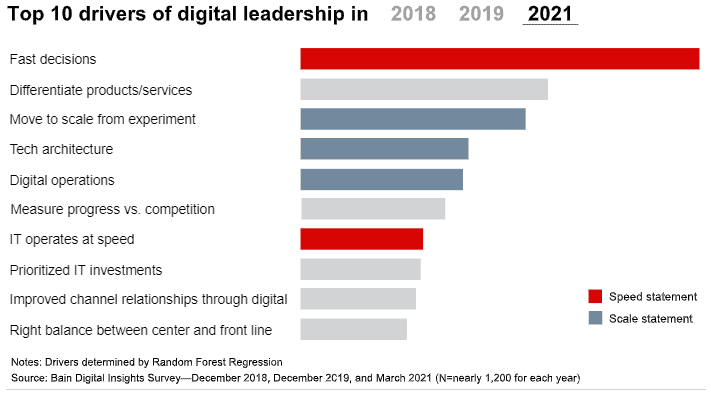Early efforts around digital transformation focused on speed to market or speed to respond to changes in market dynamics. While this is still relevant, Bain warns that promising digital transformation initiatives often lose momentum and fail to produce the broad impact needed to compete in today’s world.
In the report, Four Winning Patterns of Digital Transformation, Bain found a growing realization among leadership teams that speed alone is not enough to capture the full value of digital transformation for an organization.

Companies are now learning to prioritize scaling their best digital services to create a lasting impact across their operations. This requires retooling an organization’s technological architecture and integrating digital fluency into its business functions.
James Anderson, a partner at Bain & Company and leader of its Vector: Digital Delivery practice says companies must start analysing the needs of their business and begin creatively executing on solutions that promote digital transformation across their entire operating model.”
He cautioned that incumbent companies continue to face old problems such as a cultural divide between IT and business operations
Four key patterns that support compete and rebuild in the digital landscape

Laying down the digital foundations. This often involves companies that are under pressure to develop new digital capabilities and are essentially starting from scratch. The threat is clear and evolving steadily but has yet to produce a burning platform for change. Many industrial companies find themselves in this situation.
Integrating a fragmented digital landscape. Companies that fall into this next pattern suffer from digital fragmentation. They have no shortage of digital projects bubbling up across the company, but they lack the ability to prioritize the most promising initiatives and scale them across the organization.
Digital transformation front to back. The third pattern also confronts the legacy conundrum in the core business, but the problem, in this case, is different. Rather than a fragmented IT architecture, these companies have years of accumulated systems that were built on top of each other as the business evolved. The resulting tangle of tech infrastructure ends up being inefficient and inflexible, slowing down the company’s reaction time.
Launching a new digital attacker. Sometimes the magnitude and pace of disruption in the industry require more change than an incumbent company can support. Its size, complexity or resistance to change might prevent it from moving fast enough to remain competitive.
Increasingly, the answer is to launch an entirely new business to attack opportunities that the core business cannot. A digital attacker is both an offensive and a defensive bet.
On offence, it allows companies to enter a new market with a tailored, lightweight solution that is free of legacy baggage.
On defence, it gives the company a fresh value proposition to attract new customers within its existing market—for instance, aiming at millennials, students and young professionals to build the customer base of the future.
Laura Polasek, director within Bain & Company’s Vector: Digital Delivery practice, warns of the tendency for organizations to launch small digital initiatives that ultimately fail to move the needle
“Successful digital transformation depends on a balancing act—namely, the ability to scale meaningful change without disrupting the core,” she concluded.





